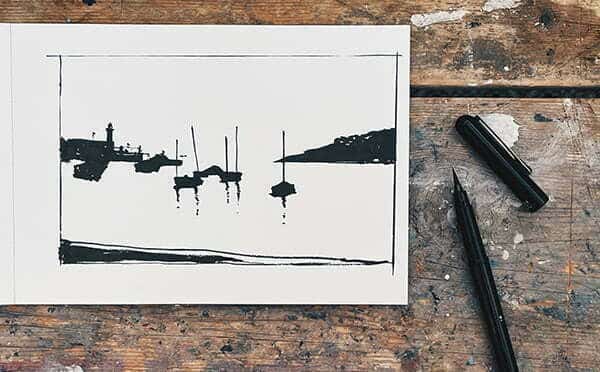
‘The combination of lights and darks especially as used in Japanese art : the design or pattern of a work of art as seen in flat areas of dark and light values only.’- Webster Dictionary
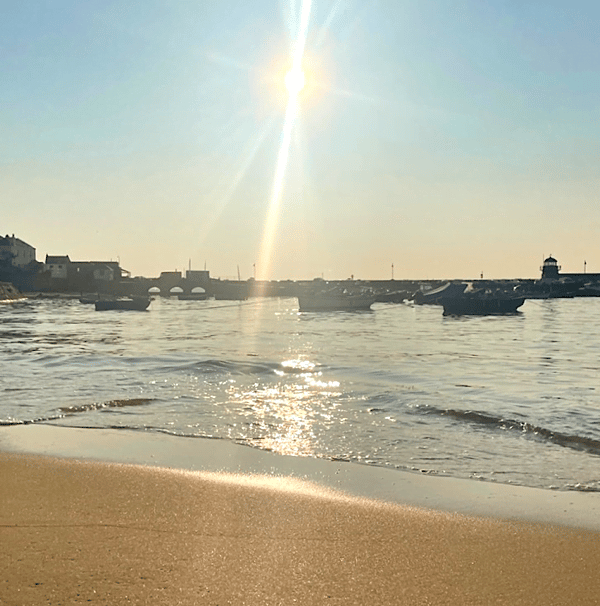
Out for a beach stroll early this morning, as the sun was coming up behind the boats in the harbour, it was an idyllic image.
I had sunlight, a beach and a view, so I took a photo on my phone, and you would think this would make a brilliant painting—a reflection in the water, the pier in the distance and the boat in the foreground.
However, I know if I painted this back at my studio, it wouldn’t work out as well as it promised.
It would be just okay.
It might still translate if I wanted to create a piece that focused on the colours of the water and sky, but the basic graphical design of the piece just isn’t strong enough to create a great painting. The boats aren’t instantly recognisable as boat shapes, and the harbour is obscured by other unidentifiable shapes.
I find three value studies or Japanese Notan studies can be surprisingly helpful in guiding your choices for creating a compelling composition in your paintings. If you were just to look at a scene in simple values or Notan, it becomes glaringly obvious what really works as a successful image.
A description of Notan
Notan (pronounced no-tan) is a Japanese term that means ‘light and dark harmony/balance.’ It’s a design concept that looks at how light and dark elements of a composition interact only using black and white.
Notan is the underlying value structure of your painting.
Arthur Wesley Dow wrote about it in his 1889 book Composition: Understanding Line, Notan and Colour as one of his 3 main elements of composition design:
- Line
- Notan
- Colour
“The term NOTAN, a Japanese word meaning “dark, light”, refers to the quantity of light reflected, or the massing of tones of different values. Notan-beauty means the harmony resulting from the combination of dark and light spaces — whether colored or not – – whether in buildings, in pictures, or in nature” – Arthur Wesley Dow
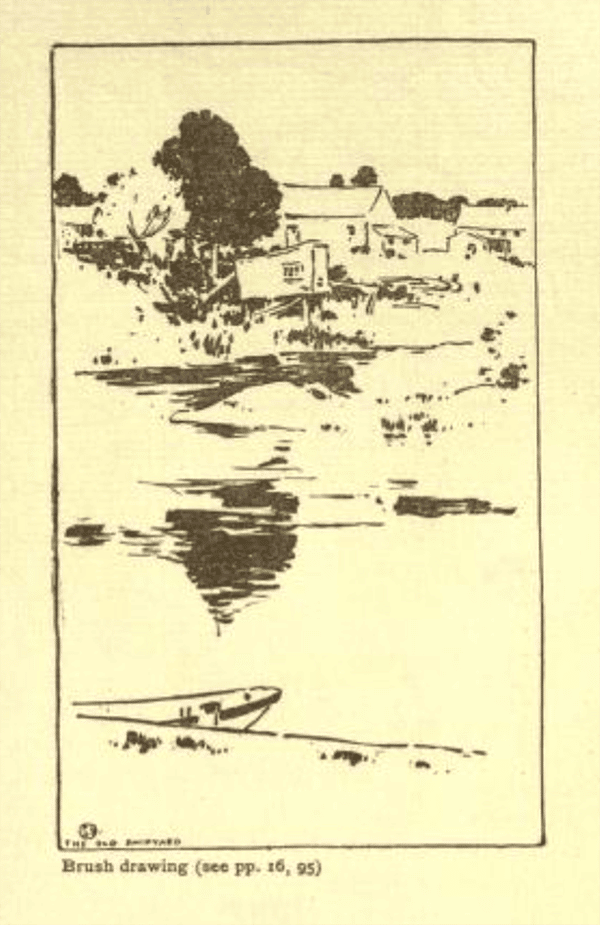
Brush drawing by Arthur Welsey Dow, from Composition; a series of exercises in art structure for the use of students and teachers
You can read his book here: Notan and Composition Arthur Wesley Dow.
Harbour scene using Notan
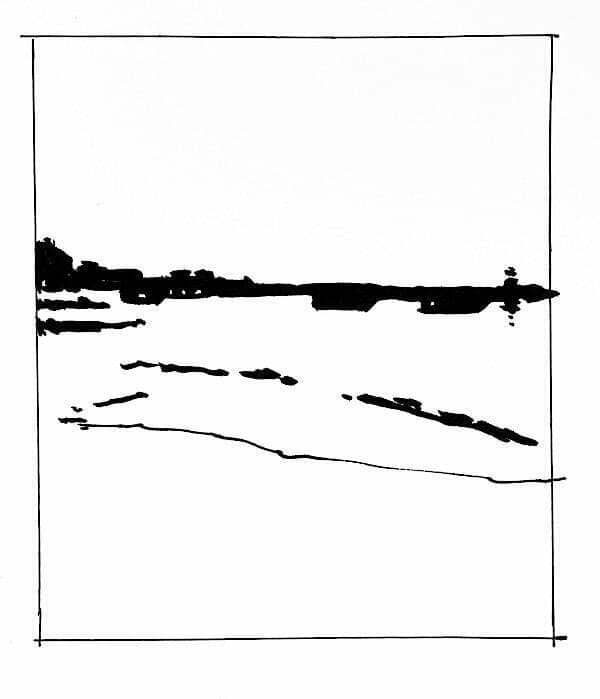
It’s an extremely simple line at the top of the composition; there isn’t really a great deal of interest for the eye in the foreground. The boat’s silhouette on the right-hand side doesn’t necessarily look pleasing, and you can’t easily distinguish what it is.
When you take images, it’s so easy to be swayed by the emotional memory of the experience of that morning on the beach, the colours (and in my case, the memory of a warm pain au chocolate I’d just eaten) and want to paint them. Although these personal experiences are all valid, for the foundation of the composition, and the viewer they don’t help it.
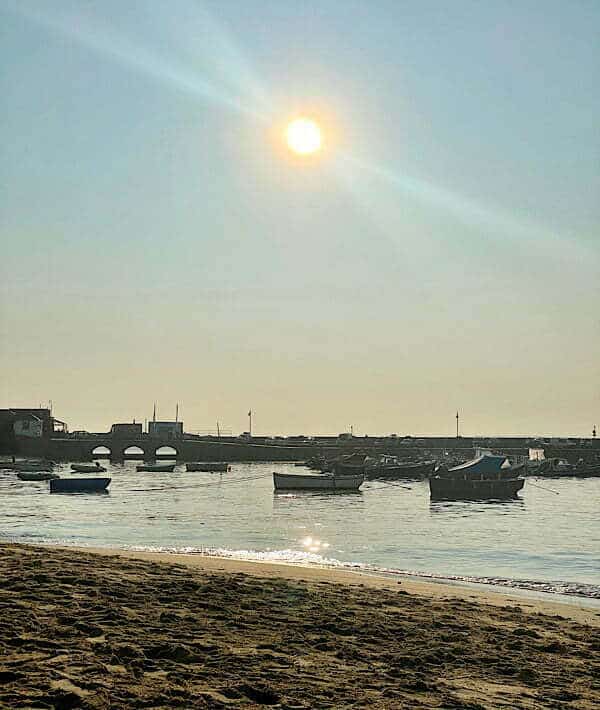
I walked forward a few paces to slightly shift my viewpoint of the same scene.
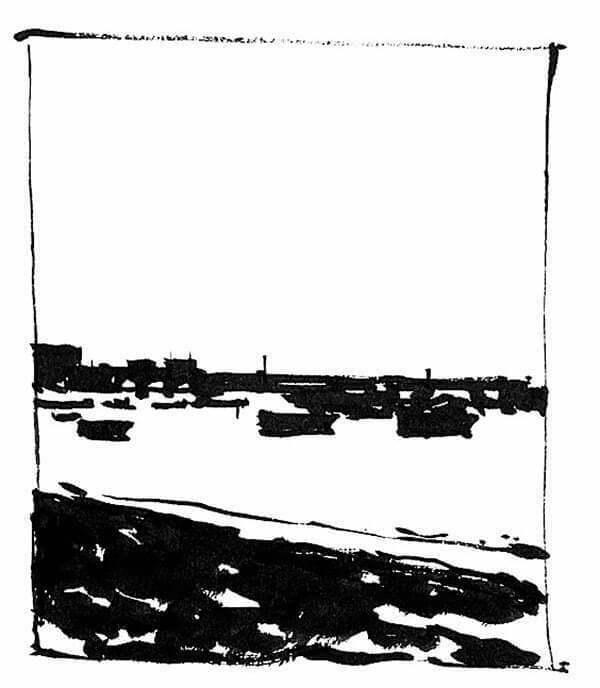
It’s instantly more ‘seascape’ like, and the beach in the foreground helps with the framing to add a sense of depth, and you can tell that the shapes are boats. There is more of an interesting pattern being formed.
How Notan can improve your paintings
Notan helps you to quickly see how the graphical design of your painting is working.
It helps your composition or choice for your paintings by creating a pleasing arrangement of shapes.
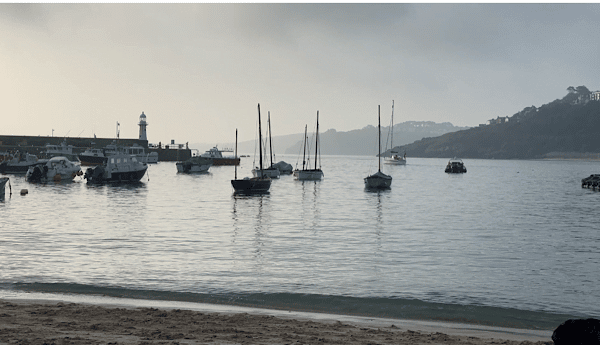
Here’s an earlier photo with mist and a very simple sky.
I noticed the boat on the right-hand side was just a blob, and the boats on the far left were too closely grouped. When you’ve only got the black and white option, your eye really tunes into the shapes.

Drawing a Notan image, then subject ‘reads’ as a sailboat on the water.
If I now remove the boat on the right and crop in the image, there is a stronger overall balance to the scene. You can start to see more interesting patterns within the boats.
This is where Notan studies can be so helpful. Notan is all about balancing light and dark and looking at the shapes and patterns within an image to see how the piece’s structure is successful.
How To Draw a Notan Study
Notan drawings were traditionally created using brush and ink. The amount of water added changed the strength of the pigment.
I tend to use a Pentel brush pen.
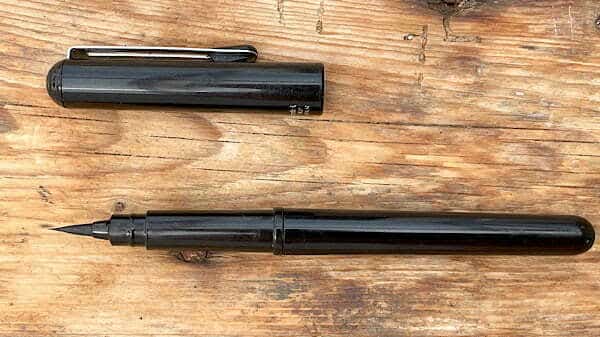
Pentel Brush Pen
I use this pen when urban sketching as you can get such a great variety of marks. You can use the fine tip to draw details and then push onto the belly of the bristles for blocking in larger areas. Using a thicker brush pens helps stop you get too into the detail and create a line drawing.
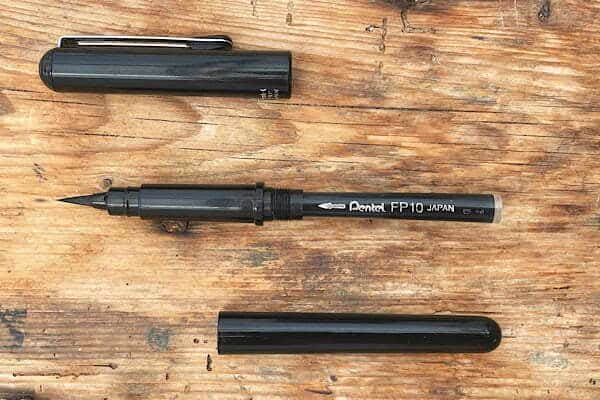
It has refillable ink cartridges and gives a nice deep black.
But if you’re first beginning, how do you decide which part to keep black and which part to leave white?
Notan studies are easiest from a photograph to start with until you get more practiced with them. Having a high contrast image will make it much easier to see the differences between lights and darks.
The first thing I do is look for the darkest darks, the bits that are definitely in the shadow family and draw those in.
Then you’ve got all the tricky mid values. You have to make a judgement call on whether they join the black or are left white.
When you have lots of mid-tones in your image
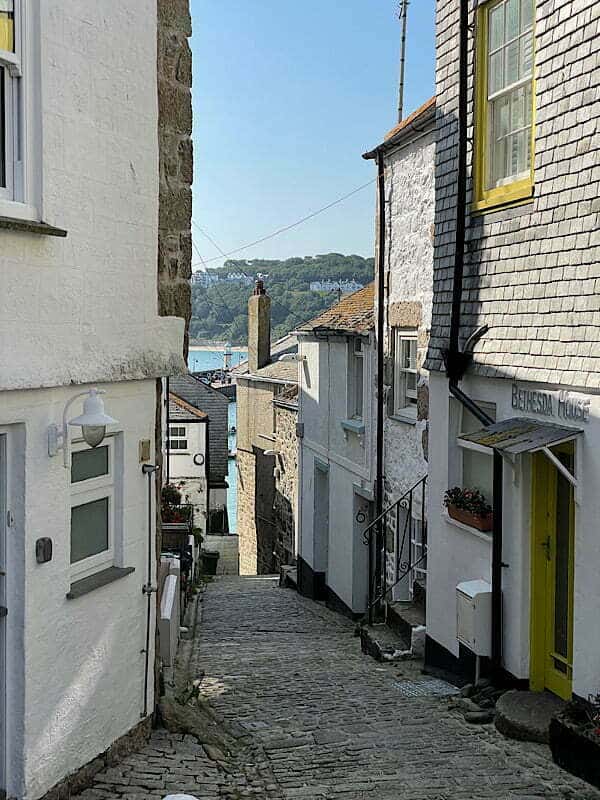
Bethesda Place, St Ives, Cornwall
How would you split this scene?
What’s in the light? What shadow pattern do you go with?
The darkest darks and light areas are the easiest.
How to use apps to help visualize notan
There are several apps available that can help you visualize notan and value studies from your reference images.
A few are:
See Value
Notanizer
See Value is handy because you can see a live view on your phone, absolutely perfect for scouting a scene. Notanizer has a few more controls in ‘weighting’ the tonal area when working in more complex value ranges.
On both apps, you can control or adjust where the balance level is for black or white. This is the key thing to remember when using them.
Here’s is the Notan of the scene as interpreted by the ‘Notanizer’ app using a weight value of 38, so just light of the middle range. The tonal scale goes from 0 to 100.
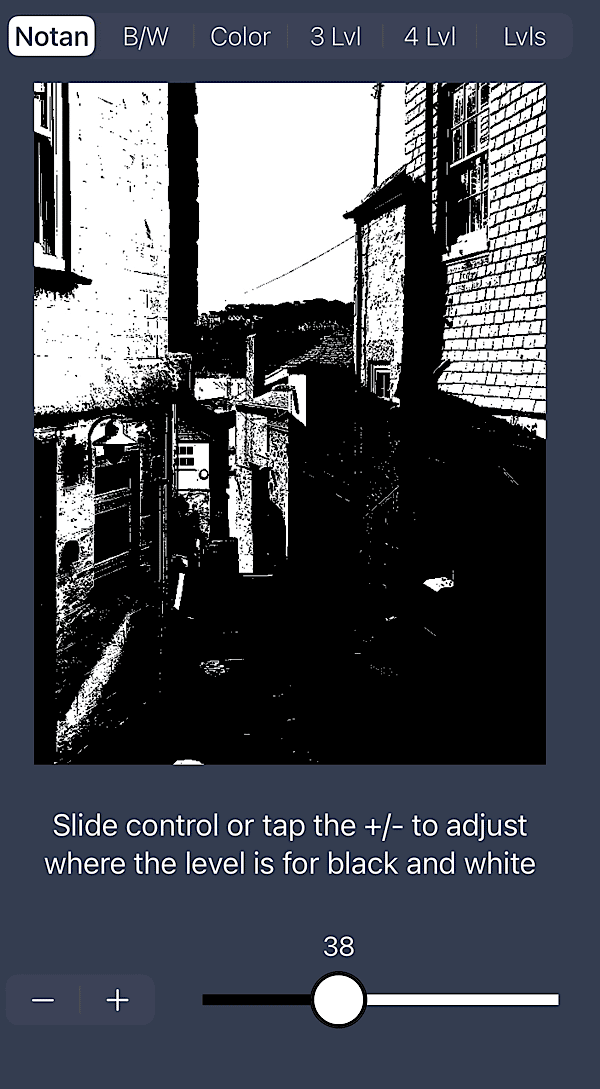
Technically it has grouped the darks and lights.
However, as a reference guide for my painting, it’s not as helpful being this heavily weighted because the main interest area I want to show off in my painting is completely now in shadow.
It’s pushed areas that are mid-tone into the darks; if I wanted to paint a dark Rembrandt style interpretation of the scene, it would be fine, but I want to paint a more impressionistic colour in the shadows style piece.
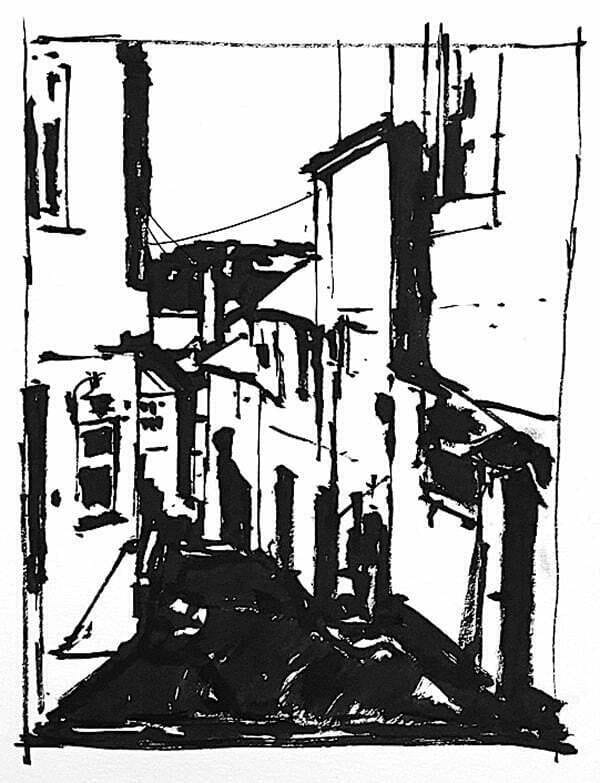
Here is my drawing without using an app; I’ve made the decision to focus more on the areas that will aid my painting. I wanted to see how the darkest areas formed a pattern knowing that the dark shadow area on the right-hand side will be painted with a mid-tone value range.
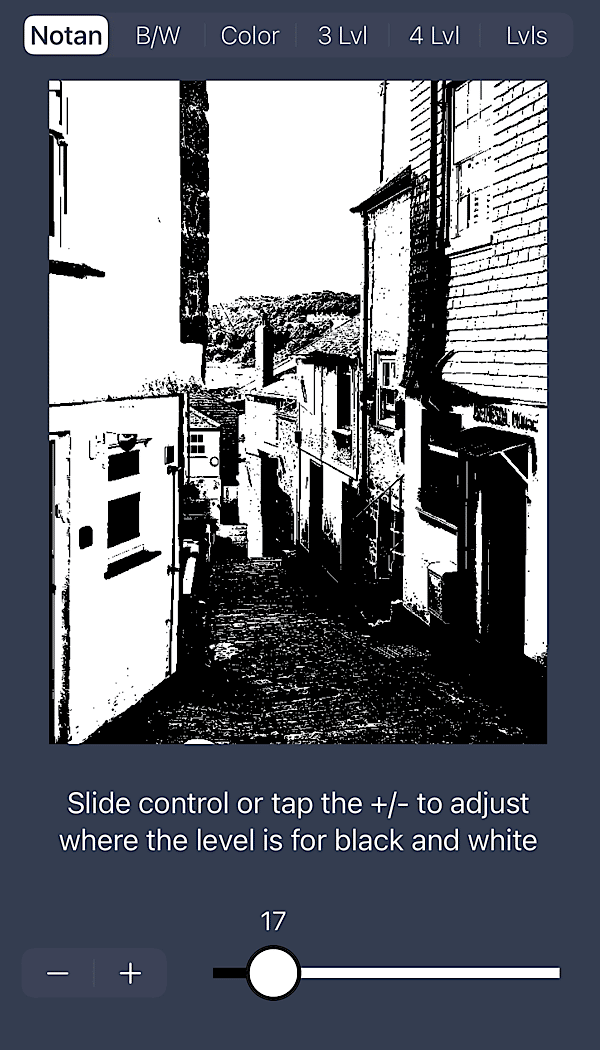
If I go back to the Notanizer app and alter the weight to around 17, it gives more of an indication of the facade details of the buildings but still highlights the dark shapes. It’s much closer to what I’ve drawn above, but it’s highlighted all the slate details on the near building, which can be a bit distracting.
So use the apps as a guide but then use your judgement on which areas enforce the shadow pattern and try not to get distracted by details.
And this is the key point to remember. You can weight the Notan depending on your personal preferences.
Three-value studies
Sometimes I also choose to use a simplified three-value split to explore the mid-tones in a scene.
If you’ve been using the coloured ground method in your paintings, you can develop your studies into three values, and these value studies can be handy to add more levels of information into your sketches.
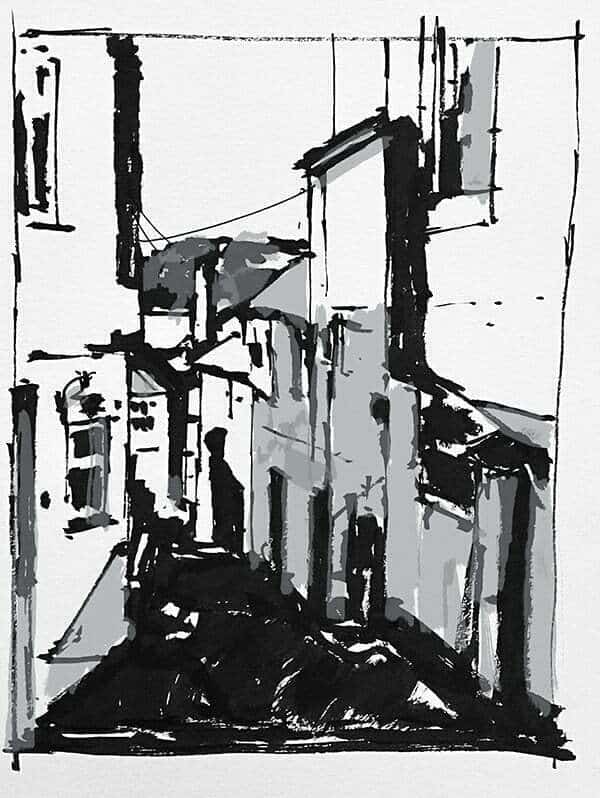
Three value study
I tend to use Tombow brush pens. The grey range can be nice for keeping your value groupings together.
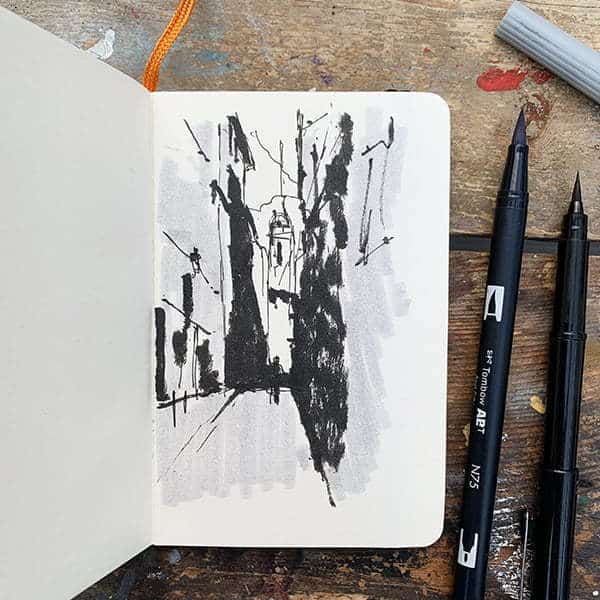
Here is a sketch using N75 tombow from the Corsican street scene tutorial.
Do you have to use Black?
No, you can create these studies in any colour. If the scene is more muted, using an N75 or N65 grey brush pen can work well. I’ll also sometimes use acrylic markers that can help you visualize the Notan painting in a hue that is more harmonious with the finished piece.

Notan painting using Yellow Ochre Acrylic Marker
Seeing the world in black and white can really help sharpen your composition and design skills; I really hope you enjoy exploring your images with Notan.
Further Reading:
Barry John Raybould has more in-depth details on various approaches to Notan and his concept of three and four value notans.
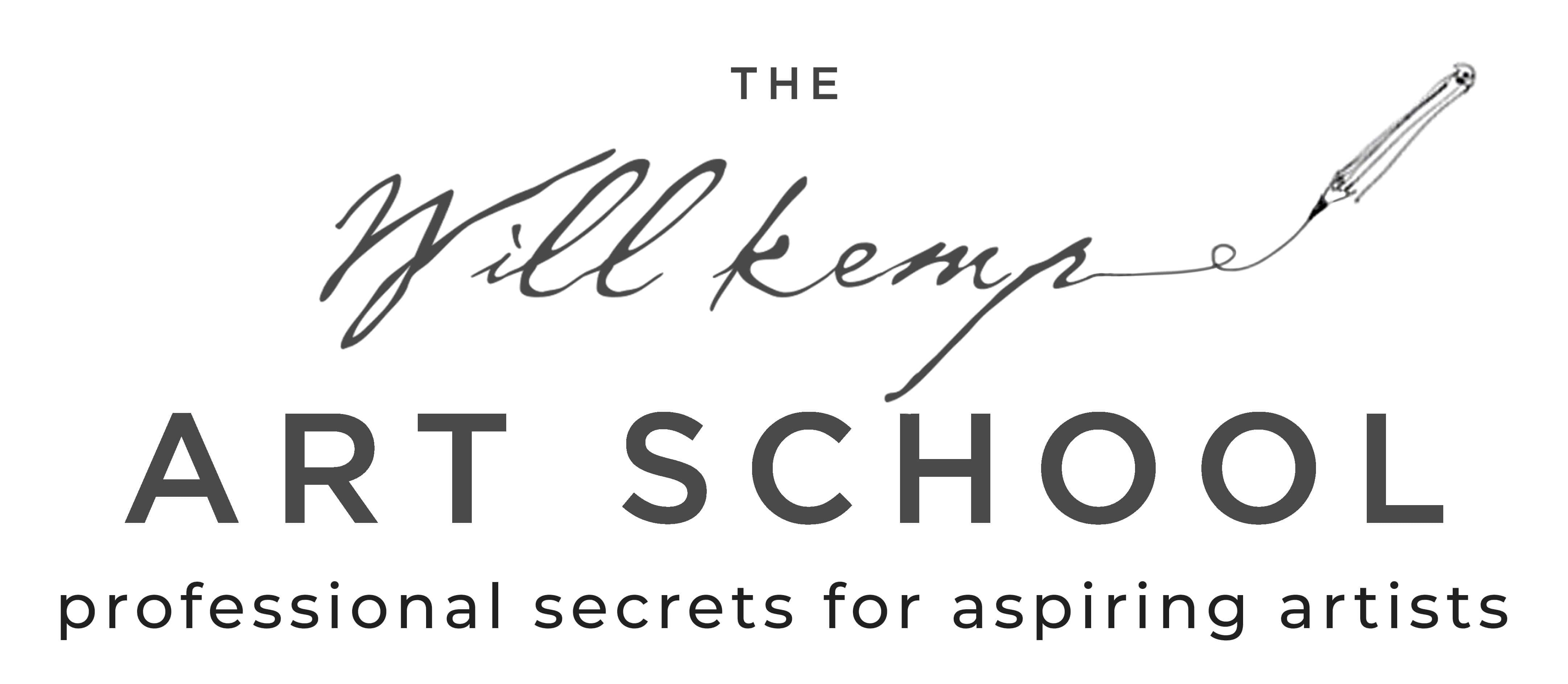
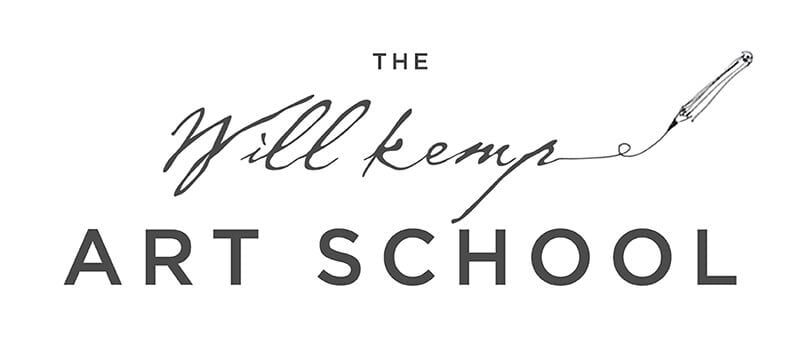



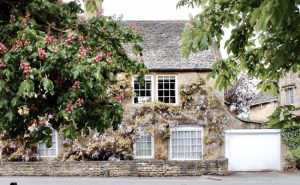
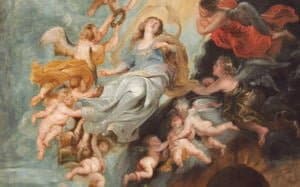
Now I want to see the finished paintings from this post. Especially the buildings.
Ha,ha, thanks Tricia, that’s good to know.
Will
Thanks Will. I often take photos for reference and then when I get home and look at them with a painting in mind, they just don’t work for me. It is disappointing. I will definitely being trying Notan in future.
Give it a try Toni, it can be very enlightening. And even doing a few different weightings of the same subject can sometimes reveal a new direction for the piece.
Will
Thank you so much for this fascinating article. I will definitely give it a try. I am wondering about the little sketch book you have. Could you please let me know the brand. I have several sketch books but I liked the marker to save your place. Many thanks
Marianna
Glad you enjoyed it Marianna. The small sketchbook is from the Hand.book Travelogue range. I think Hand.book are now known as speedball travel journal.
Cheers,
Will
Thanks Will, for your wonderful and generous post and explanations. I need to do this “homework” before I pull out the paints….something that is a big challenge for me! APPRECIATE YOU!!
Really hope it helps Mary.
Love this article and your suggestions! I was not familiar with Notan but it makes perfect sense as a way to organize and prioritize a composition. Many thanks for your informative, entertaining articles, Will!
Best,
Grace
Thanks Grace, hope you find the method helpful.
Will
This study arrived just in time! I waste a lot of time setting up still life’s, taking pictures and analyzing them. This is a simple time-saving technique. The Notan app is already helping with my latest still life set-up. I can see what is wrong immediately. I am off to warm a pain au chocolate (I too buy them!) and sit outside in the garden before I begin my next project because I have time and confidence in my composition. Thanks, Will.
Sounds like the perfect combination Karen! so pleased you’ve found it helpful in your setups.
Will
As always; concise, insightful and very useful information from the Maestro. I will be sure to test my compositions using Notan methodology prior to committing to a painting. Thank you Sir
My pleasure Tom.
Thanks Will. Fascinating stuff. Dianne Mize alerted me to Notan (she with the wonderful southern US drawl)….shadder and not shadder…
Glad you’ve been finding your Notan studies helpful Roger.
Will
I’ve been doing thumbnails that are sort of notan without knowing the Japanese name. Great idea to use the brush, bought some ages ago and hardly ever use them. I will now and will try a middle value. Thank you for sharing.
Hope you enjoy experimenting with them Sue.
Will
That’s so helpful Will, thank you, you are so generous with your tips. I’ve been trying to do something like it with Photoshop but it’s hardly plein-friendly. Lovely to see your move to Cornwall and the new studio. All happiness to you and your family there
My pleasure Susan, hope you find using the apps more convenient.
Cheers,
Will
Thanks Will! I always look forward to learning something new from you. You are a gifted teacher and lay things out so logically. I’m going to start your course on painting the Venice scenes I purchased. I can’t wait!
Great stuff Bianca, we look at some tonal value studies in the Venice course so these are a great primer.
Cheers,
Will
What a fascinating and interesting post from you Will. I am sure that most if not all of your students can empathise with the Notan method or should I say, problem.. As usual, what a turn up again from you Will.
When up pops your email it makes you want to read it all to the end – like a good book!
Thanks for your kind words Charles, hope you enjoy experimenting with the technique.
Will
Thx Will that s a great help.
Good one Nigel!
I thought this article was really interesting and helpful. Composition is so crucial. I hadn’t heard of Notan, but have recently become interested in the difference between Oriental and Western composition ideas. When I build collagraph plates, I have to think tonally right from the start so that I select the right materials. Your article has come at the right time, and I am grateful for your generosity in sharing it.
So pleased you found it helpful Genny, with your collagraph skills they should come quite naturally.
Will
This is an amazing app Will, thanks for sharing! It helps tremendously on which photo would make a good painting!
So pleased you’re enjoying it Diane.
I really love this article and can’t wait to try it out on my walk tomorrow. As always thanks Will for sharing the love
So pleased you enjoyed it Belinda, hope it helps reveal some new views on your morning walk.
Will
Just loved reading this post. Thanks Will, inspiring
So pleased you’re feeling inspired Viv.
Will
This was great Will. My iPhone can turn photos into black and white which I use but would Notan be better. I have trouble with seeing mid value nuances. Thanks so much.
Hope you find the value levels helpful Tracy.
Will
It’s funny that I’ve never tried this before. It gives me some great new ideas. Thanks, Will!
That’s fab to hear Bob.
Will
I have been really working on theory lately. I find composition a challenge. Thanks for this. Very helpful.
Thanks Jane.
Love and have learned a lot from all of your videos. It’s wonderful that you and your family are in Cornwall and you keep the rest of us informed on how to improve via your informative newsletters.
Thanks
My pleasure Linda.
Will
Thank you for taking time to write this very informative piece. I’m not familiar with Notan, but it makes sense as a way to organize a composition. I’ve been studying more how composition and value can really make a painter stronger. This is one piece of information to add to my tool box.
Really hope it helps Pippin.
Cheers,
Will
Great blog post, Will! This is the next step in drawing I’ve been looking for without knowing. Does this principle feature in your landscape drawing course? I’m keen to sign up if so!
Hi Sri, we don’t specifically look at Notan design in the landscape course, more looking at value studies but still using pens.
Will
I too will now dig out those brush pens for plein air work.
Your articles are always inspiring. I forward them to many artist friends.
You live in a beautiful part of the world, like me on an island surrounded by koalas and natural beauty.
How can we not be artists…thanks for sharing, Will
Hey Syl, yes the brush pens can be so handy. Thanks for sharing the articles, much appreciated.
Will
Thank you for all you teach , am a grandma , whom after many years will take up painting again
Great to hear you’re finding time for your painting Olga.
Cheers,
Will
Thank you, Will!! Valuescales are great helps!!
God bless, C-Marie
My pleasure C-Marie.
Will
Thanks Will,
This is very enlightening. When I do a landscape I’m often disappointed that my painting doesn’t translate to what I felt when I saw the landscape or photographed it. So, now I know how to alter the elements and look closer at the composition using the Notan method, I’m feeling a bit more enthusiastic at giving landscapes another go.
Hey Janet, so pleased to hear you’re feeling more enthusiastic about your landscape sketching, hope the notan drawings help.
Will
Thank you so much Will for this special Notan design study. I have been struggling to get the preliminary sketch right for my landscape painting; taking many photos, staring at its variety of magical colors under different degree sunlight…no success yet. I will try the methods you instructed here this week. Thank you again!
Really hope you find the Notan helpful Julia.
Will
Thank you so very much for the information about Notan Design. It is very useful and I will certainly try it out.
That’s great to hear Monique.
What a brilliant article Will. Thank you so much and I am definitely trying this out!
Good one Bernadette, hope it goes well.
Will
Thank you, Will! I am a landscape painter and the comparison examples are very helpful in understanding how what looks like a wonderful ‘reflection’ painting might not work as well as moving to a slightly different direction in which the values really make the composition.
So pleased you found it helpful Colleen, yes Notan’s can be so helpful for landscapes, really hope you enjoy experimenting with them.
Will
Thank you Will for your article on Notan. I have not heard of it before but your tips will help my sketching and tonal values a great deal. I have taken so many pictures of the landscapes & seascapes around St. Ives and Cornwall with a view to painting one or two. I regard myself as a novice and composition is not my strong point. I tend to put too much in. I will definitely use the Notan process you’ve shown us and at last I can use my pentel brush pens that I bought many moons ago. They are all still working. Your post and article just came in at the right time for me. Thank you Will for your generosity. I would love to see those sketches in canvas and maybe your studio and paintings if it is open to the public.
My pleasure Anita, great that the brush pens are still going strong, really hope it helps with your compositions.
Will
Thank you Will. This is very useful. I love the way you explain things! I hope your studio is tucked away enough for you to have enjoyed the summer in Cornwall. I have ordered my pens! Sally.
Hope you enjoy them Sally, they are great pens.
Will
Really great article.
Thank You!
Thanks Vicki
My wife and I really love your approach to painting and design and your wonderful happy spirit and warmth towards us amateur painters!Thanks Will!
So pleased you’ve both been enjoying the articles Barry.
Thank you Will. I’d never heard of Notan before so interesting.
Really hope it helps with your compositions Esther.
Will
Hi Will,
Interesting! I’m a art hobbyist and … well … trying to catch up on the fly. And from the beginning of pursuing this passion I was drawn (haha) to the contrast of Notan, but didn’t know it was an actual design concept. I’m recalling a particular beach scene I painted several years ago from Maui with a few palm trees and other elements being black since the sun was setting behind the mountains on Lanai. So even though the ocean between was in different shades of blue and the sky was red and purple, the most interesting thing about that scene to me was the dark silhouettes in view. This lesson is especially important to me and I can’t thank you enough.
So pleased Laura, yes the silhouette shapes can be so helpful.
Will
Thank you for sharing.
HI Will, this article is such an eye opener! Thank you so much for sharing your thought which is so valuable! I will use the apps only as a tool while apply Notan rules to practice! Since I started my painting journey, you have been one of the best art teachers I have ever had! Keep up the good work and I look forward to your new art courses and postings!
Really hope they help Helen.
Cheers,
Will
Wow how have I never heard of this term. I got a tingle of excitement in my stomach reading this. As an artist who paints deep shadows and bright highlights I can see how this would be very useful. Educational as always Will. Thanks!!
So pleased Laurie, really hope you enjoy experimenting with Notan.
Dear Will
Thank you – I read about Notan in an art magazine years ago. but it did not make sense. This does greatly. You went as far as to show the mid tone which really made even more sense of it all.
Thank you so very much – it brought back memories of visiting St Michael’s Mount and the demonstration tells me I need to get back to drawing and even painting again.
I need to get rid of all except the essentials in my flat – then I can start.
Best wishes, Rosemary
So pleased you found the explanations helpful Rosemary, yes a minimalist approach can always help.
Will
Appreciate your sharing this Notan tool. I’d been using different photograph apps to tweak my pictures into black and white or extreme color versions to approximate what Notan does much more easily. Thanks, Will.
Great stuff Jennifer, really hope it helps.
Will
We used to do a similar techique using X-ray films and a very strong developer in the photography school… The result was exactly like what you show. This brought back long lost memories in my youth days when I attended all kinds of night schools.
Great to hear Joe.
Richard Schmid taught to use the secret squint. When you squint your eyes, the details will be blurred and you will see the patterns of light and dark. I think it’s better to squint then to use an app as a crutch.
Hey Steven, wow, what a privilege to have been taught by Richard, such an inspirational artist. Yes, squinting down can be so helpful for viewing your work.
Will
New to Notan but I purchased the app and started in with it. Used it on a ref photo I’d already used for a painting I was really struggling to complete. Once I ran the ref photo through the “Notanizer”, I immediately identified the problem. I’m a convert! Most helpful for “seeing the forest instead of the trees!” Thanks so much for the info!
Good one Jen, so pleased you found the app helpful.
Will
That is really helpful so I’ll be rereading it , then trying the method. Thankyou.